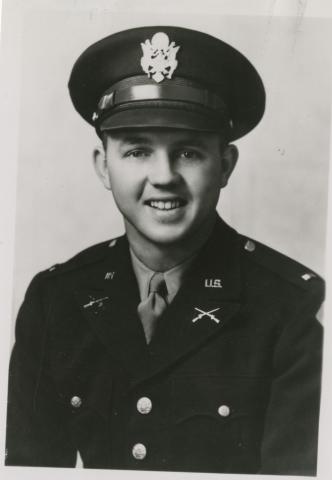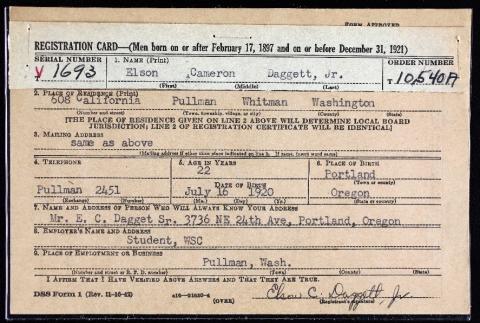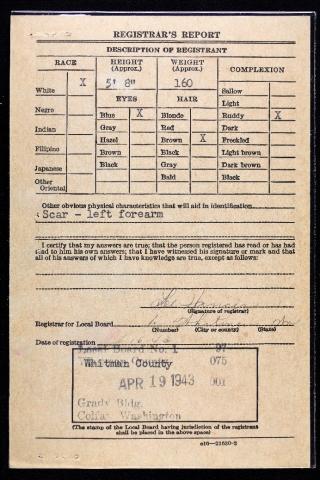Elson Cameron Daggett, Jr.
Pre-WSC Background
Elson Cameron Daggett Jr. was born on July 16, 1920, in Portland, Oregon. Elson was the second son had by his parents, Elson C. Daggett Sr., and his wife Olive Guy Daggett. Elson Sr. was originally from Washington but married Olive and had their first son, William G. Daggett, in Iowa before settling in Oregon. The Daggett family continued to grow as the couple later added another son and daughter, Robert A. and Olive J., respectively. Interestingly, Elson Jr. appeared in the 1930 Census by the name of Cameron, the first instance of Elson going by a different name. The family settled in Gladstone, a small town only twelve miles south of Portland. Though Elson attended grade school in Gladstone, he went to West Linn High School, which is located a few miles south of Gladstone and across the Willamette River. In 1938, Elson graduated from WLHS in 1938 and enrolled at Washington State College for the upcoming fall semester. At WSC, Elson had some of the finest years of his life.
WSC Experience
Far from home and in a brand-new location, Pullman and WSC offered many opportunities for Elson to make a name for himself. As Elson began his first semester at WSC, he quickly pledged to the Sigma Chi fraternity. When the new pledges from the various fraternities were listed, he was listed as “Cameron Daggett” once more. Elson’s nicknames varied during his time at WSC, with examples such as Elson, Cam, or Cameron. Elson’s involvement in Greek life was one of the defining aspects of his time at WSC and in March 1939, he was formally initiated into Sigma Chi. Later that spring, Elson demonstrated his interest and talent in another organization, the WSC baseball team. Despite the popularity and visibility of the football program, WSC boasted an impressive baseball program that was renowned as one of the best in the Northwest. Under the leadership of the legendary Arthur “Buck” Bailey, WSC baseball was near at the top of the standings each season. Though confined to the Freshman team for the season, Elson quickly established himself as a talented, up-and-coming infield prospect. At the end of the season, he was listed among some of the other talented freshman players, displaying an excellent .378 batting average. For his strong first season on a freshman team that won ten games and lost only one, Elson was rewarded by earning a class numeral for his outstanding performance in his freshman campaign. With his first year at WSC concluded, Elson had set himself up well for a memorable remainder of his college career.
Beginning his sophomore year, Elson continued to serve and participate deeply in fraternal activities. In November, Elson was a part of the Sigma Chi intermural football team when they took on Kappa Sigma. Though he was a terrific baseball athlete, his dropped catches on sure touchdowns indicated that football was not his sport. His involvement in the fraternity continued beyond intermural sports and simple membership, as Elson was also involved in the Chinook Business Staff. As a part of the group that helped create the annual yearbook, Elson served as a part of the Men’s Group House Representatives. Though he was branching out, Elson aspired to be a leader in Sigma Chi. By the end of his sophomore year, Elson was elected as a pledge advisor, heralding his rise through the leadership of the fraternity. As he was moving up in the fraternal realms, Elson was also growing as a solid player for the Cougar baseball team. After moving up from the freshman squad, Elson had to compete for a roster position against many other talented players. He eventually won a spot on the team, but as a centerfielder rather than in the infield. Though he had little experience or ability at the position, Elson’s speed helped to give him a chance. The 1940 season proved to be a successful campaign, as the Cougars finished second in the division with an overall record 18 wins and 10 losses, but had only nine wins in conference play with six losses. Despite an overall solid record, the main culprit that handicapped the Cougars’ success that season was the lack of offense. While there were a few batters who had success in the season, most of the team did not hit well as even Elson struggled with a lowly .171 batting average. Even with a sophomore slump, Elson proved to be a valuable player for the team. As the season came to a close, he was awarded a letter in baseball. With a difficult season over, Elson looked forward to 1941 as a comeback campaign.
With the start of the 1941 season, many fans focused on Elson and the many other players who had struggled offensively the year before. For his part, Elson, now playing second base part-time, paid back for his lackluster sophomore season with a strong junior year. After starting off the season with a mediocre batting average, Elson rebounded late in the season. Over the span of three games, he raised his average from .231 to a solid .285, much to the delight of Coach Bailey. As the season ended, the Cougars finished with a slightly worse record than the year before. Now with 17 wins and 13 losses overall, coupled with an 8 win and 8 loss conference record, the Cougars tied for third place in the division. Nevertheless, the Cougar team had shown a marked improvement in offense, a heartening sign for the program. Elson in particular displayed improvement, finishing with a batting average of .333, tied for third-best on the team. For this solid season, Elson was rewarded by the Athletic Council with a sweater and emblem. With the first half of his college career completed, Elson already established himself within his fraternity and on the baseball team.
Before the 1942 baseball season began, Elson rose from a player fighting for a place on the roster to an integral part of the team and even WSC athletics as a whole. Before the season began, Elson served as a chairman for a semi-formal dance held by the Grey W, a group made up of star WSC athletes. Now back at second base, Elson had garnered the nickname of “Sootin’ Cam Daggett” and was making his last season another strong campaign. After an early series against Whitman College, Elson attracted great attention after excelling on defense and offense, owning a spectacular .555 batting average for the series and stealing four bases. Despite starting the season off strong, Elson and the team slumped through the rest of April and into May. Once again, the WSC offense collapsed as Elson held the highest batting average on the team with a .286 average. As the season concluded, the Cougars rebounded and played well enough to tie for second place in their division, with an overall record of 23 wins and 11 losses but with a mediocre seven wins and seven losses in league play. Elson played his final season of baseball, ending his career at WSC as one of the star players. In midst of a year where he was undoubtedly busy with fraternal obligations and schoolwork, he was getting involved in another organization. With America at war and likely to be involved in the conflict once graduated, he joined the Scabbard and Blade, an ROTC honor society. Elson had only one more year to complete his education and then join the military, leaving this the last year he was able to truly leave his mark on the college.
As he had done throughout his time at WSC, Elson was once again involved in many different groups but was securing greater positions and honors in his final year. Elson was one of nine students who were inducted into the Crimson Circle honor society on the basis of his campus activities. The lengthy list of positions held by Elson shows a great deal of accomplishment from years of service. Among the various councils and committees such as the President’s Council and the Interfraternity Council, he was the elected the President of Sigma Chi and Vice-President of the Grey W Club. Among his peers in the Chinook yearbook, Elson’s many positions and honors stand out, making him one of the most well-known and active students at WSC. After almost five years at WSC, Elson graduated with his degree in Economics. With his college career over, Elson was looking forward to only one thing, serving his country in the armed forces. On April 19, 1943, he registered for service in the nearby town of Colfax.
Wartime Service and Death
After graduating from WSC and enlisting into the Army, Elson was sent to Fort Benning, Georgia for training. By October 1943, he had completed his training and earned his commission as a Second Lieutenant in the infantry. Elson had some free time in between assignments and used it to travel back to the Pacific Northwest. He stopped in Pullman, his home in Portland, and Spokane to visit his fiancée, Mary Lou Ford. Once his trip concluded, Elson traveled to Camp Roberts, California to meet with other officers. When it came time to depart the United States, Elson was a part of the 383rd Infantry Regiment of the 96th “Deadeye” Division. By 1944, the war situation was decidedly different than it had been in previous years for the US. Now ready and mobilized for combat on two fronts, the US was planning massive offensives in both Europe and the Pacific during the year. The 96th left the States and began training on the Hawaiian Islands from July to September 1944 in preparation for action in the Philippines, a major offensive that was slated to meet stiff resistance. By October, the Division was ready for combat and landed in Leyte Gulf on October 20.
As the 96th Division landed on Leyte, they encountered some resistance on the beaches by Japanese defenders. The defenses faced during the landings were quickly overcome, but greater resistance awaited as the American soldiers ventured deeper into the island interior. After being tasked with taking the Tanauan-Dagami-Tabontabon sectors, the men of the 96th got caught in heavy fighting that lasted until November 9. Once captured, Japanese resistance gradually declined as small actions like patrolling and eliminating small pockets of Japanese troops took place until late December. Elson and the rest of the 96th battled stubborn defenses but overcame them with grit and determination. For his service in the campaign, Elson received a promotion to First Lieutenant on December 9 and was given a Combat Infantryman’s Badge for his participation in combat. Though Japanese resistance to the Philippines lasted well into 1945, the 96th Division did not spend much longer on the islands. A new and far more deadly invasion involving the “Deadeyes” was being planned for the following year.
With major actions on Leyte being concluded by December 1944, the 96th had time to rest and reorganize for future operations in the Pacific. Though Japan was clearly no longer able to win the war, it was far from defeated and major actions in 1945 were being planned to finally end the war. For the next three months, the 96th mainly focused on light duties and training for the upcoming invasion of Okinawa. On March 27, the 96th departed the Philippines for Okinawa and were slated to join in the initial invasion on April 1. The invasion began and when the soldiers landed on the island, they encountered no resistance as the Japanese occupied better defensive positions to the south. As the 96th advanced to meet the defenders, they met the first major lines of resistance on April 7 near the Gakazu Ridge. On April 8, near the village of Uchitumari, Elson was directing the set-up of machine guns when he was exposed to enemy fire. Japanese artillery rained down on the American troops, killing Elson in the bombardment. Elson Cameron Daggett was killed in action at the age of twenty-four, leaving behind his parents, siblings, and fiancée. For his courage in this action, he was awarded a Bronze Star and his superior, Colonel Edwin T. May, wrote a letter to the Daggett family after his death. Colonel May expressed that in every action in Okinawa and in the Philippines, Elson displayed courage and leadership and that “he was in every sense a true soldier.” Only a few months later, the battle of Okinawa was over and World War II ended with an Allied victory. Elson was initially buried in Okinawa but was reburied at the Lincoln Memorial Park in Portland, Oregon. Years later, Daggett’s name was also added to the WSU Veteran’s Memorial, along with every WSC soldier who fell during World War II.
Postwar Legacy
Elson Daggett’s life and death highlight much in terms of determination, leadership, and service. At WSC, Elson arrived as an unheralded young man from Oregon but had great aspirations with what he was going to accomplish while at college. He worked his way up from a pledge in his fraternity and one of many good baseball players on the freshman team to eventually a star player and the president of his fraternity. He worked tirelessly in school, in his fraternity, and in his sport, earning his popularity through countless hours of work and good leadership skills. Despite being of shorter statue, Elson commanded great respect and admiration from his peers. When it came time to serve in the military, Elson served with the same determination and natural leadership that he cultivated at WSC. He fought fearlessly in combat and gave his life while leading his fellow soldiers during one of the final battles of the war.





